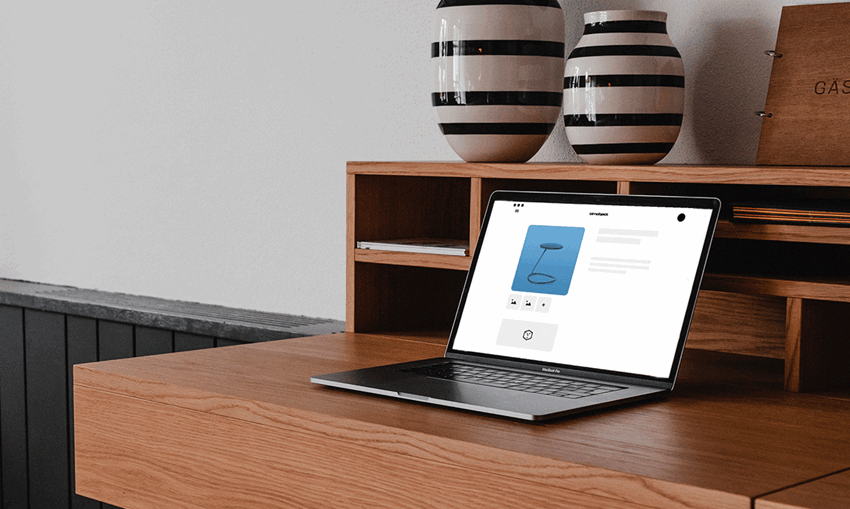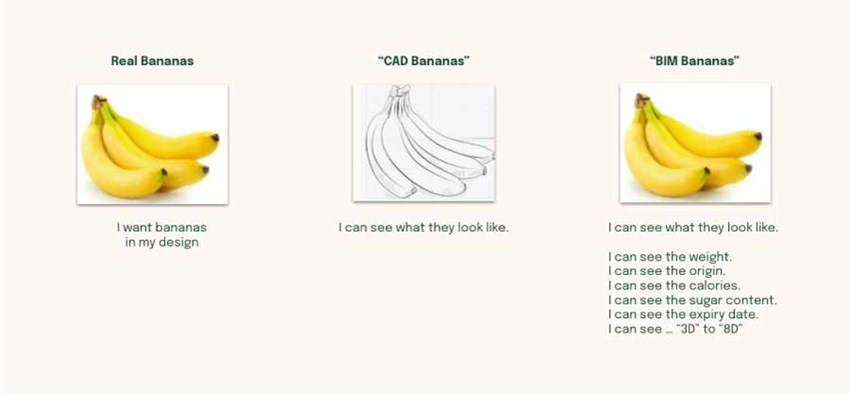Why BIM bumps the likelihood of getting specified
Specifications are the golden goose for manufacturers. But if you want to get in, you have to get your products and the information into the right hands.
The formula is fairly straightforward: the more information you have available at the start of a project, the easier it is to get included in the design and the project specification.
Pre-BIM product specifications were sent over on a pdf. Manually. But that’s not going to cut it in the future. Why? Because it’s not particularly efficient for either parties when:
- designers are working towards tighter and tighter deadlines and can't be bothered to waste precious time rummaging through documents
- you need to spend time and money reaching architects, drumming up interest, and manually sending over the right information in the hopes of getting specified.
It’s a headache. But luckily, there’s a way to soothe the information frustration. So, let’s explore what BIM is, what BIM means for manufacturers, and why it's critical for getting deals in the future.
What is BIM?
BIM, short for Building Information Modeling, is a digital building process where information about every single component is managed across the project team and throughout its lifecycle.
The building process gives architects, engineers, contractors, and owners/operators (AECO) precise information about a building model’s physical and functional components. Which, in turn, makes it easier to plan, design, and build in a smarter, faster, and more sustainable way.
There’s no denying that BIM will play the lead role in the future. But how can you, as a building product manufacturer, get a headstart in the race? Well, you need to supply them with BIM objects.

What is a BIM object?
Remember when we said that BIM includes information about a building’s physical and functional components? Well, a BIM object is that very component.
Unlike CAD, BIM objects go way beyond physical appearances. A BIM file is a digital representation of a real-life product, yes. But the digital representation is a dynamic and intelligent 3D model that contains data about the product. Check this picture for comparison:

BIM objects can be made available in a range of file formats. This, of course, depends on what type of BIM software your market prefers. Although we help to create BIM content in a wide range of file formats (ArchiCAD, Revit RFA, Sketchup SKP, AutoCAD, Filmbox), we always recommend Revit and ArchiCAD as a minimum.
> Psst! Did you know that BIMobject Insights can help you figure out what type of format you should focus on for which product category and market? Take a tour to find out how!
Why manufacturers need BIM
BIM is revolutionizing purchasing decisions. Many professionals, states, federal departments, and cities have encouraged or mandated the use of BIM. So, ensuring that your products can be specified as components of a BIM project is critical for keeping your business in the purchase cycle.
BIM isn’t a matter of “if”. It’s not a matter of “when”. It’s a matter of now. Here’s why:
1. Architects, engineers, and designers want BIM
BIM adoption is accelerating. More and more designers, architects, engineers, and contractors are awakening to the perks of working with BIM: it speeds up the design process, enables smoother coordination, saves money, and saves the planet.

But what does all of this have to do with you as a manufacturer? It trickles down into one core thing: giving your audience what they need, which are BIM objects to populate their BIM projects. Icons of Denmark’s CEO explains how BIM (and the BIMobject marketplace) works to build business value:
"The ability to reach the right audience and deepen their experience with Icons by servicing their need for BIM models in a simple and convenient way, is a huge benefit and value-add for us.”
> Read the full interview with Jesper Møllgaard Jensen.
The bottom line is: you want to reach architects and engineers. Get specified. Expand and grow. But you can’t do either of those if you’re unable to match their requirements. Expecting to get specified in BIM projects without supplying BIM objects is like bringing pork chops to a vegan potluck and wondering why nobody’s eating…
2. Digital tools are entering the new normal in construction
Would it shock you if we said that the construction sector is one of the least digitized industries in the world? Probably not, right?
It’s a sleeping giant in the need of a wake-up call. But the sand is seeping through the hourglass faster than ever before. The driving force? COVID-19, the absence of trade shows, and a digital change in behavioral patterns.

In a recent report on our industry’s new digital landscape where we surveyed 2,568 architects, engineers, contractors, and owners/operators (AECO), we found that:
- 52% find that their work has become "a lot more digital" since COVID-19
- 61% expect an uptick in digital tools post COVID-19
- 46% of use search engines to discover new products, while only 9% of find them at trade shows
- professionals are working later and more on the weekends – 33% traffic increase on BIMobject.com on Saturdays and Sundays.
Sidenote: digitization delivers sharper ROI
Don't get us wrong: we’re not saying that digital tools will render trade shows obsolete. But they do offer something that the physical counterparts simply can’t: measurable real-time data that allows you to track every buyer's journey, improve brand reach, product traction, and ROI.
During our recent webinar about digitalization, Anders Johansen, European Channel Manager at Electrolux, made quite a compelling case for how digital tools enable them to track and measure ROI and KPIs:
The ongoing digitalization process will force building product manufacturers to think of better ways to market and sell their products. Are you on the right track?
> Find out how BIMobject’s digital marketplace can help you increase your reach and results.
3. BIM is critical for sustainability in construction
Let’s face the music: our industry is responsible for inconceivable amounts of greenhouse gas emissions and incomprehensible volumes of waste. To add fuel to the fire: CO2 emissions from the building sector are at an all-time high, representing 38% of the world’s total.

But the question is: how does BIM pave the way for sustainability? Well, every component contains information that’s collated into a common data environment. This gives all stakeholders involved in a project the ability to examine and mitigate the project’s impact on our beloved mother earth by:
- running simulations of the building’s life cycle energy
- assessing product and material life cycles
- calculating statements about energy and embodied carbon dioxide
- forecasting volumes to minimize waste
- examining the future performance of the assets
- avoiding construction faults before the shovel even nicks the ground.
So…
If you’re a brand that climate compensates, uses sustainably sourced raw materials, or just cares about the environment in general – supplying BIM objects for BIM projects should be a priority.
4. Governmental BIM mandates and initiatives
Rome wasn't built in a day, they say. Well, urbanization and the world’s population are on such a growth spurt that contractors will need to build 13,000 (nope, didn’t slip on the zeros) buildings every day through 2050. So, it seems like the idiom may need a little revision... Getting back to the point:
Such a steep rise in urban population puts immense pressure on government bodies to expand and improve public buildings, health, and infrastructure. But…
Funds don’t grow on trees. Cost overrun in one project may make another stall or even fall. So, countries, states, and municipalities are realizing that they need to procure projects that deliver on time and on budget without jeopardizing the public's well-being or the environment at large.
Seems like a tall order, right? Well, that’s exactly why governments are mandating BIM. Not only does the method provide a way to build smarter, safer, and greener, but it also offers a way to get maximum value out of scarce funds.

According to ECSO’s Building Information Modelling in the EU construction sector, full-scale digitalization in non-residential construction would lead to annual cost savings of:
- $ 0.6 trillion to $ 1.0 trillion (13% to 21%) in the engineering and construction phases
- $ 0.3 trillion to $ 0.4 trillion (10% to 17%) in the operations phase.
So, governments are putting pressure on public procurements and influencing adoption in the private sector. If contractors want to win public bids, they need to saddle up with a team of engineers and architects that speak BIM. And what do they need to facilitate their work and populate their models? That’s right: BIM objects from manufacturers such as yourself.
Is it hard or expensive to get BIM objects?
Let’s be honest: getting started with new ways of working is never easy. Humans tend to seek the path of least resistance, and implementing new work processes is not it.
But the danger of inaction outweighs the initial risk. Sometimes you need to get out of your comfort zone. Clear out the what-ifs. And build a smoother road that cuts down the time to the target destination.
It’s the same with BIM.
You need to invest time and money to make the wheels spin. But the return is there: both in terms of creating a future-proof competitive edge and in creating a more efficient and profitable pipeline.
The harsh reality is that the world is changing. The climate is changing. And the construction industry is starting to change, too. So, it’s up to you to decide if you want to be in the lead or get outrun by your competition.
Want to know how BIM can fit your business and get you specified?
Take a tour to find out how!


Sarah Chase
Global Content Marketer













